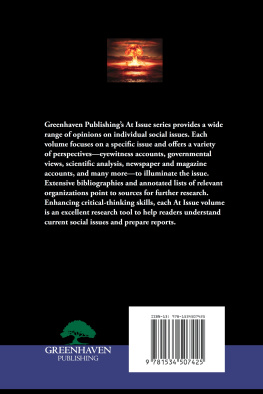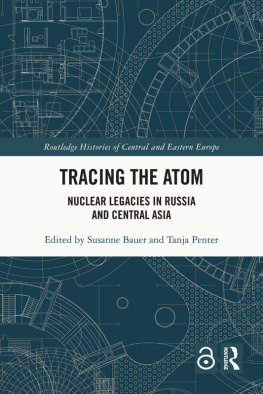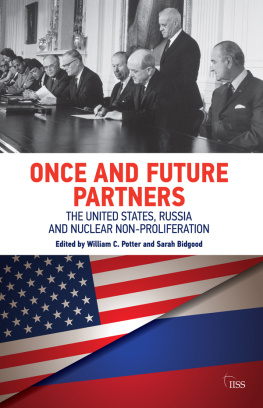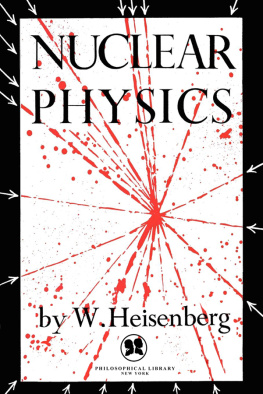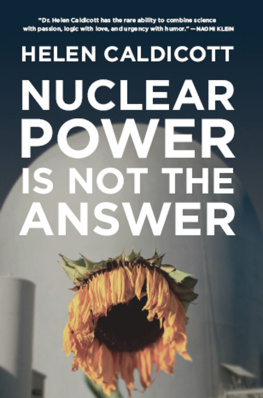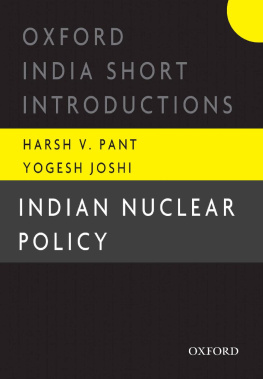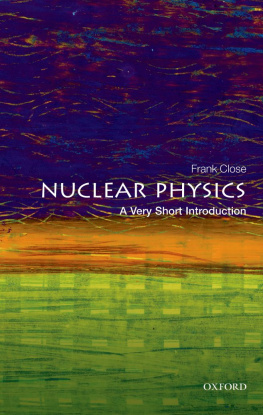NUCLEAR RUSSIA
Russian Shorts
Russian Shorts is a series of thought-provoking books published in a slim format. The Shorts books examine key concepts, personalities, and moments in Russian historical and cultural studies, encompassing its vast diversity from the origins of the Kievan state to Putins Russia. Each book is intended for a broad range of readers, covers a side of Russian history and culture that has not been well-understood, and is meant to stimulate conversation.
Series Editors:
Eugene M. Avrutin, Professor of Modern European Jewish History, University of Illinois, USA
Stephen M. Norris, Professor of History, Miami University, USA
Editorial Board:
Edyta Bojanowska, Professor of Slavic Languages and Literatures, Yale University, USA
Ekaterina Boltunova, Associate Professor of History, Higher School of Economics, Russia
Eliot Borenstein, Professor of Russian and Slavic, New York University, USA
Melissa Caldwell, Professor of Anthropology, University of California Santa Cruz, USA
Choi Chatterjee, Professor of History, California State University, Los Angeles, USA
Robert Crews, Professor of History, Stanford University, USA
Dan Healey, Professor of Modern Russian History, University of Oxford, UK
Polly Jones, Associate Professor of Russian, University of Oxford, UK
Paul R. Josephson, Professor of History, Colby College, USA
Marlene Laruelle, Research Professor of International Affairs, George Washington University, USA
Marina Mogilner, Associate Professor, University of Illinois at Chicago, USA
Willard Sunderland, Henry R. Winkler Professor of Modern History, University of Cincinnati, USA
Published Titles
Pussy Riot: Speaking Punk to Power, Eliot Borenstein
Memory Politics and the Russian Civil War: Reds Versus Whites, Marlene Laruelle and Margarita Karnysheva
Russian Utopia: A Century of Revolutionary Possibilities, Mark Steinberg
Racism in Modern Russia, Eugene M. Avrutin
Meanwhile, In Russia: Russian Memes and Viral Video Culture, Eliot Borenstein
Ayn Rand and the Russian Intelligentsia, Derek Offord
The Multiethnic Soviet Union and its Demise, Brigid OKeeffe
Nuclear Russia, Paul Josephson
Upcoming Titles
Art, History and the Making of Russian National Identity: Vasily Surkiov, Viktor Vasnetsov, and the Russias History Painters, Stephen M. Norris
Russia and the Jewish Question: A Modern History, Robert Weinberg
The Soviet Gulag: History and Memory, Jeffrey S. Hardy
The Afterlife of the Soviet Man: Rethinking Homo Sovieticus, Gulnaz Sharafutdinova
Russian Food since 1800: Empire at Table, Catriona Kelly
A Social History of the Russian Army, Roger R. Reese
Why We Need Russian Literature, Angela Brintlinger
The Ballet Russes, Ira Nadel
A Territorial History of Russia, Paul Werth
Black Encounters with the Soviet Union, Maxim Matusevich
The History of Birobidzhan, Gennady Estraikh
NUCLEAR RUSSIA
THE ATOM IN RUSSIAN POLITICS AND CULTURE
Paul R. Josephson

CONTENTS
| BN | The Soviet Breeder Reactor |
| ICBM | Intercontinental Ballistic Missile |
| INF | Intermediate-Range Nuclear Forces Treaty (1987) |
| KIAE | Kurchatov Institute of Atomic Energy |
| kW | Kilowatt |
| LMFBR | Liquid Metal Fast Breeder Reactor |
| LTBT | Limited Test-Ban Treaty (1963) |
| MAD | Mutually Assured Destruction |
| MinsSredMash | Ministry of Medium Machine Building (the Soviet Nuclear Ministry) |
| MIRV | Multiple Independently Targetable Reentry Vehicle (multiple nuclear warheads on one missile) |
| MW | Megawatt |
| NPP | Nuclear Power Plant |
| NPT | Treaty on the Non-Proliferation of Nuclear Weapons (1970) |
| PWR | Pressurized Water Reactor |
| R and D | Research and Development |
| RBMK | Channel-graphite reactor (the Chernobyl type) |
| Rosatom | The inheritor of Minsredmash programs in Russia |
| SALT I | Strategic Arms Limitation Agreement (1972) |
| SALT II | Strategic Arms Limitation Agreement (1979) |
| SLBM | Submarine Launched Ballistic Missile |
| START I | Strategic Arms Reduction Treaty (1991) |
| START II | Strategic Arms Reduction Treaty (1993) |
| UFTI | Ukrainian Physical Technical Institute |
| VVER | The Soviet/Russian PWR |
| WMD | Weapons of Mass Destruction |
| ZATO | Closed Administrative-Territorial Formation (closed military cities) |
The work leading to this book was funded in part by Colby College internal grants and assisted by discussions with students in my various courses. Erik Ananyan was an able research assistant. Funding from the National Science Foundation Grant 2020024, A Global Nuclear Environmental History, was crucial in this work. Several colleagues over the years have helped me better to understand the evolution of the nuclear enterprise generally and the Soviet Russian case in particular. The anonymous reviewers for this book and the Russian Shorts series editors offered important suggestions and critical comments. Natalia Melnikova provided critical comments and corrections on an earlier draft of this book. Tatiana Kasperski has taught me a lot about the history, science, and politics of nuclear waste, about the Chernobyl disaster, about the public and technology, and about nuclear history across the globe. I dedicate this book to Tatiana with lifelong thanks.
Nuclear Russia?
At the height of their power, the Soviets commanded 39,000 nuclear warheads, yet claimed to be servants of the peaceful atomwhich they also pursued avidly. They built warheads and rockets, uranium enrichment facilities and reactors. They built the worlds first reactor to produce power for the civilian grid. They embraced the atom as a sign that the advanced socialist system rivaled western capitalism, especially the United States. Physicists carried great authority in the USSR and today in Russia. Citizens were rarely permitted to protest against state programs, but in the case of nuclear power, at least until the Chernobyl disaster (1986present), they, too, believed that the atom secured the nations borders and provided cheap, safe and plentiful energy. This book examines both military and peaceful Soviet and post-Soviet nuclear programs for the long durebefore the Second World War, during the Cold War, and in Russia to the present.
Nuclear Russia covers much more than Russia. From the 1917 until 1991 the nuclear Soviet Union existed. After the breakup of the USSR, the nuclear nations of the former Soviet empireUkraine, Kazakhstan, Belarus, the Baltic statescontinued major programs in nuclear research and development, in energy production, and in dealing with the legacy of Soviet nuclear waste, safety and other concerns. The atom in Ukraine has a long and difficult nuclear history. It was one of the founding nations of the world in nuclear physics in the 1920s and 1930s (as we shall see), contributed to the Soviet atomic bomb project after the Nazi retreat and defeat, had one-third of the Soviet nuclear arsenal, and, of course, is home to the Chernobyl disaster. To this day Ukraine produces over 50 percent of its electrical energy from nuclear power. Lithuania had two Chernobyl-type RMBK 1,500 MWe (megawatt electric) reactors on its territory, closing them both to accede to the European Union by 2010, although it continues to debate building another reactor of western origin. Kazakhstan was home to the Semipalatinsk nuclear test site of hundreds of weapons tests, the BN350 breeder reactor on the Caspian Sea, and had 1,400 nuclear warheads and undisclosed number of tactical nuclear weapons when the Soviet Union collapsed. Belarus, with its own extensive reactor development program, had eighty-one single warhead missiles stationed on its territory in 1991; all were transferred to Russia by 1996. In May 1992, Belarus acceded to the Nuclear Non-Proliferation Treaty (NPT). Today it is bringing on line a Russian-produced VVER1200 pressurized water reactor (PWR).
Next page


